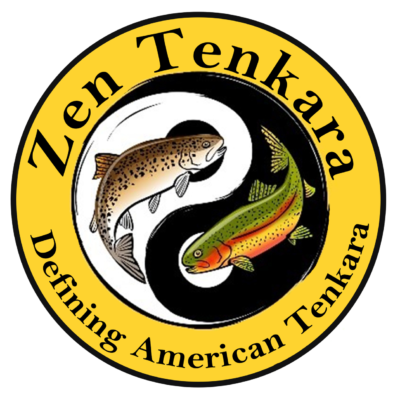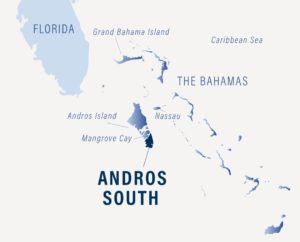 As I’m preparing to pack for my upcoming trip to South Andros Lodge in The Bahamas, I’m pondering gear and clothing. I’m trying to combine absolute necessities with other items I just generally would like to bring. I’m gradually condensing my things into smaller and smaller pieces of luggage. I will say, traveling to a warm climate is always easier than traveling to fish in a cold one, but a pitstop in Fort Lauderdale and dinner with friends means I can’t go complete grunge, or at least I prefer not to. Over the years I’ve collected a lot of gear and fishing apparel. I’m finally getting to the point that I know what works and multifunctional items that hold up over time are the biggest factors that sell me. Just like our own Zen products, I want stuff that performs and lasts.
As I’m preparing to pack for my upcoming trip to South Andros Lodge in The Bahamas, I’m pondering gear and clothing. I’m trying to combine absolute necessities with other items I just generally would like to bring. I’m gradually condensing my things into smaller and smaller pieces of luggage. I will say, traveling to a warm climate is always easier than traveling to fish in a cold one, but a pitstop in Fort Lauderdale and dinner with friends means I can’t go complete grunge, or at least I prefer not to. Over the years I’ve collected a lot of gear and fishing apparel. I’m finally getting to the point that I know what works and multifunctional items that hold up over time are the biggest factors that sell me. Just like our own Zen products, I want stuff that performs and lasts.
For starters, I’m a solid fan of the Fish Pond Teton luggage pieces and have both the Grand and the Carry On. I love that Fish Pond is a Colorado company like Zen and buying local when it’s possibly is always a plus.
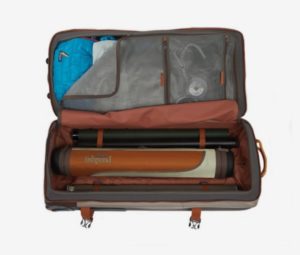 The Grand Teton is a massive vault. It can hold all my clothing, toiletries, rods, reels and tenkara gear. It’s big and tough and holds it all in one place. I like that I can check it and forget it. It has sturdy wheels and a solid pull handle so even though it can hold a ton, it’s still pretty maneuverable, except for stairs. That’s the one scenario where this piece can really remind you just how much it can carry in a not-so-good-sort-of-way. As I said, it holds a lot, which means it can get heavy very quickly when packing all your personal items and fishing gear into the one piece.
The Grand Teton is a massive vault. It can hold all my clothing, toiletries, rods, reels and tenkara gear. It’s big and tough and holds it all in one place. I like that I can check it and forget it. It has sturdy wheels and a solid pull handle so even though it can hold a ton, it’s still pretty maneuverable, except for stairs. That’s the one scenario where this piece can really remind you just how much it can carry in a not-so-good-sort-of-way. As I said, it holds a lot, which means it can get heavy very quickly when packing all your personal items and fishing gear into the one piece.
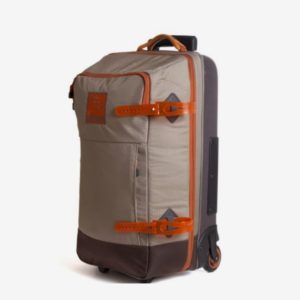 The Teton Carry On is the smaller version and laid out the same way, just in smaller dimensions. It holds more than it looks and while I can’t fit my traditional rods inside of it, I can fit some of my tenkara rods into the piece. Plus, it has exterior rod straps so if you use it as a real carry-on and don’t check it, you can strap a rod to the outside. I like that it’s manageable in tight places and I can handle it comfortably while climbing stairs. It also has those sturdy wheels like it’s big brother the Grand Teton, that can even handle dirt roads and is made tough to withstand lots of bumps and dumps, but is much less cumbersome.
The Teton Carry On is the smaller version and laid out the same way, just in smaller dimensions. It holds more than it looks and while I can’t fit my traditional rods inside of it, I can fit some of my tenkara rods into the piece. Plus, it has exterior rod straps so if you use it as a real carry-on and don’t check it, you can strap a rod to the outside. I like that it’s manageable in tight places and I can handle it comfortably while climbing stairs. It also has those sturdy wheels like it’s big brother the Grand Teton, that can even handle dirt roads and is made tough to withstand lots of bumps and dumps, but is much less cumbersome.
For my past several fly fishing trips, I’ve moved away from the single “hold-everything” philosophy, to a 2 piece Fish Pond combo of the Teton Carry On and a roll-top waterproof gear bag Fish Pond doesn’t seem to make any longer (but I love). I split all my gear and personal items between both bags and use the roll-top as my carry-on/personal item. It’s very compressible and depending on how much you stuff into it, can fit under a seat on a plane or in the overhead bin. Since it’s waterproof, the roll-top bag also functions as my dry boat bag while fishing. At the end of the trip, it can hold my boots/waders and all my wet or stinky stuff.
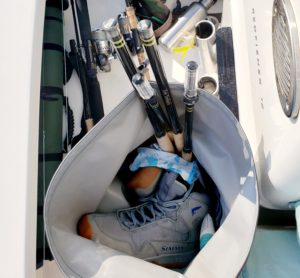
Then, the Teton Carry On holds everything else – in particular, all those items that airline carriers don’t like or allow you to bring on board including pliers, flies, sometimes my reels and lines, etc. This two bag system has been working great for my travel needs. Plus, I can balance the roll-top bag on top of my Teton Carry On and manage both bags with considerable ease with neither being too heavy or clumsy.
I’ve also made some additional changes to my saltwater gear attire. In the past, when I travelled to warm water destinations like Mexico, the Maldives, Costa Rica and the Seychelles, I wore long, quick-dry, zip-off pants. You know the type. Shorts always seem enticing and I’ve done them a few times in the past, but always end the 8hr day of flats fishing with sun burnt knees, thighs and calves. I see pictures in magazines and wonder how they do it. Maybe they aren’t out there for 8 hours? Maybe they have some access to shade? Maybe they’re just used to it? I’m a native Floridian who now calls Colorado home. I guess I’ve lost my ability to tan. As I’ve gotten older, I also see the results of long hours in the sun on my skin. Even though I’m starting late, I now want protection from the sun.
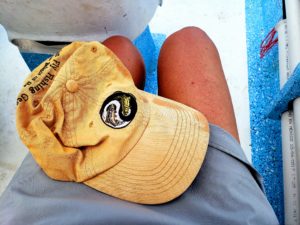
Bare skin also makes you more vulnerable to nasty sea critters like sea lice and jellyfish that can leave your legs covered in welts or small bloody bites that sting when you pull them off. One experience with a bad case of sea lice, combined with a sunburn and shorts for my flats fishing is now a big no-no. I’ll leave the bare legs for the bar and beach and expose them during cocktails after fishing.
Another issue with saltwater fishing and wading in pants is all that loose, billowy, lightweight material. It’s cool and feels airy when standing on-deck on the boat, but in the water all that fabric acts like loose sails in the water. They fill out and float around, and make moving fast, hard. I want something with less resistance but still offers my skin breathable sun protection.
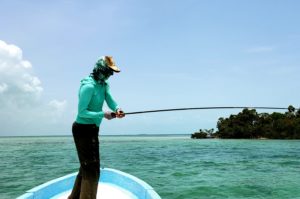
Last year when I fished at Alphonse in the Seychelles, I noticed all the guides wore leggings or tights with shorts on top. When I asked them about it they all confirmed that the tights had less friction and created less resistance in the water than long pants, making it much easier to wade and much less tiring when walking the flats all day. Tights also offered skin protection that shorts did not. I liked the concept.
As a female, wearing leggings are pretty common. My husband however, was less thrilled. We did a little research and investigating though, and found several options that were male specific and used by surfers and divers. These are made tougher for saltwater exposure, have sun protection and don’t get baggy or loose in the water like a pair of long underwear would. Some even have pockets that can securely hold a pair of pliers, a small fly box or a waterproof camera/phone. He even found one pair with reinforced knees and shins. Pretty cool.
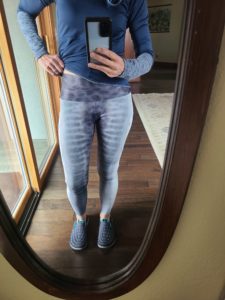
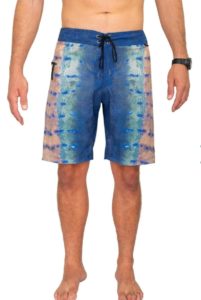
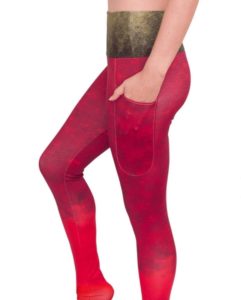
I found several options as well. One in particular that I’ve fallen in love with, Waterlust. They offer options for both men and women and their stuff is supercool because not only are their leggings and other apparel made really well and highly functional, but Waterlust is environmentally responsible: The material they use is made from plastic water bottles! 88% RPET (recycled polyester made from post consumer plastic bottles) and 12% spandex. Material that does good. Even better, they donate 10% of profits to leading marine research and education organizations including:
- Bahamas Marine Mammal Research Organization, Abacos Bahamas
- Alaska Salmon Project, University of Washington
- Marine MegaFauna Foundation
- Marine Turtle Research, Ecology and Conservation Group, Florida State University
- Coral Morphologic
- SHARK Research and Conservation
- Alfred C. Glassell, Jr. Sustain Laboratory, University of Miami, FL
- The BillFish Foundation
- Debris Free Oceans
- Alachua Conservation Trust
- Get Inspired
- MOTE Marine Laboratory, Sharks and Rays Conservation Research Program
- MOTE Marine Laboratory, Coral Reef Restoration Program
- REEF.org
Finding a product that not only functions great in the water by reducing friction, resistance and weight is fantastic for any angler, but also knowing that product is helping to protect the very water I Love and fish (and the special creatures in it) well, that’s just beyond awesome.
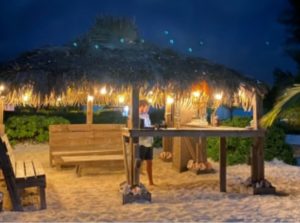
So, as I start pulling my gear and begin packing for South Andros, I’m trying to pack lighter and smarter. My Waterlust leggings are going in first, a few Simms Sun shirts and Bugstopper Shirts for evening wear are also must-haves. Flip-flops for sure and my Simms Wading Booties, plus a few other items also get packed. Then, my Zen Taka and Kyojin tenkara rods and my Winston 8wt and 10wt and Hatch reels (just incase). Way too many flies (my next project), and an assortment of different test leaders also go in. Sun gaiters and gloves, bug spray and sunblock, 2 pairs of sunglasses and my hat… Packing and travel has become a sort of science that I’m finally getting the hang of. Lighter, smaller and smarter that’s what I’m aiming for and think I’m off to a pretty good start.
Next up will be a recount of the trip. Look for it at the end of February.


